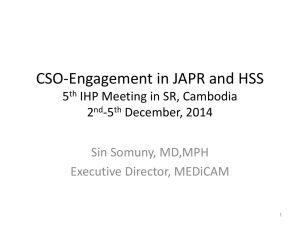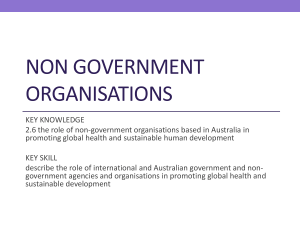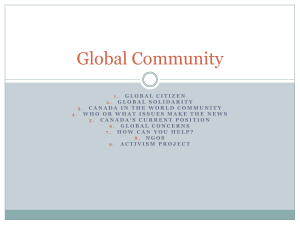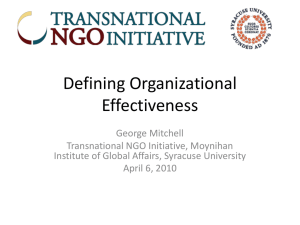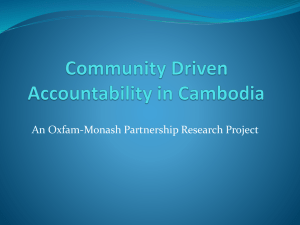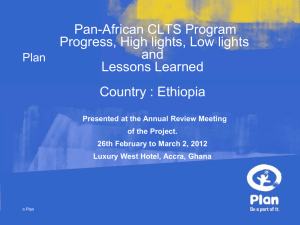Sector Capacity Study Water and Sanitation, Zambia
advertisement
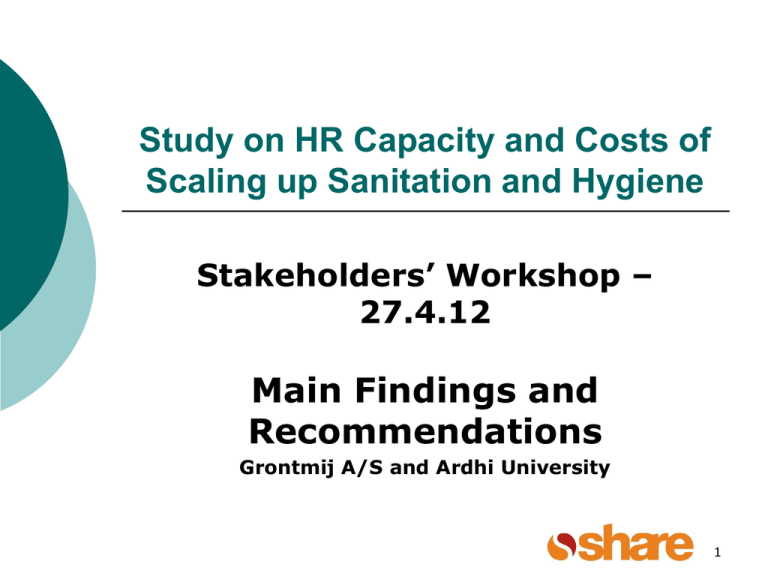
Study on HR Capacity and Costs of Scaling up Sanitation and Hygiene Stakeholders’ Workshop – 27.4.12 Main Findings and Recommendations Grontmij A/S and Ardhi University 1 Overview of Presentation • Purpose and Scope of Study • Overall Approach • Main Findings on HR Capacity • Main Findings on Current Costs • Potentials to Leverage HH Investments • Preliminary Recommendations 2 Purpose and Scope (1) • • HR Capacity – Assess existing and required HR capacity (government, private sector, NGOs) to deliver a national programme, incl. institutional set-up or structures required for coordination and implementation of national sanitation and hygiene activities Financing – Identify costs of scaling up sanitation promotion and related software costs during & beyond lifespan of National Campaign; assess potentials to leverage finance from hhs for sanitation improvement; identify ‘pinch points’ and ways in which public finance can be used to stimulate private and hh investment 3 Purpose and Scope (2) The scope of the study is: • Sanitation as related to safe disposal of human excreta, i.e. toilets/latrines in hhs, schools, health centres, public places; • Hygiene as related to HW practices & availability of HW facilities w. water & soap; • Study focus on software costs of scaling up; hardware costs are not covered; • Study covers Mainland Tanzania only 4 Overall Approach (1) • • Literature review Questionnaire survey Public Inst. & Parastatals - Central: 8 Public Inst. – Regional: 2 WSSA: 1 LGAs: 5 Private contractors: 4 Local NGOs: 13 Training Inst.: 6 5 Overall Approach (2) • • Interviews: Public Inst. & Parastatals - Central: 9 Public Inst. – Regional: 1 WSSA: 1 LGAs: 5 Wards: 7 Private consultant: 1 Artisans: 4 Local NGOs: 12 Training Inst.: 6 Limitations: Access to people & data in DSM 6 HR Capacity Findings (1) MOHSW lead: • 23 staff in Env. Health, Hyg. & San. Dept. • 5 staff in Water, Food & San. Unit, incl. 2 on study leave; 2 vacancies • 6 staff by June 2012; 7 staff by mid 2013 • 7 staff in Unit + additional staff in other Units in Dept. assessed to be sufficient 7 HR Capacity Findings (2) • • • • MOW’s Rural Sanitation Section has 4 staff, w. 2 vacancies; suggested to consider dissolving this section as future MOW rural S&H responsibilities not appearing to need full-time input from several staff; Other ministry and central inst.: no S&H staff shortage; Not assessed necessary to increase S&H staffing at regional level; Some capacity gaps at national level; 8 HR Capacity Findings (3) Regional and district WSSAs: • Sanitation involvement limited to sewerage and some trucks, 11 cities/towns w. sewerage in category A; • As indication, DUWASA no S&H capacity problems, though staff still need training; • Since 2009, training programme for weaker WSSAs; • WSSAs expected to be able to attract qualified staff (some financial autonomy); 9 HR Capacity Findings (4) LGAs: • S&H activities not assigned to specific staff in health & water dept., together with lack of funding may be reason for relatively low priority to S&H in many districts; • New District Dept. for Cleanliness and Environment (Idara ya Usafi na Mazingira) planned in July; pure prevention, incl. S&H • MOHSW: Dept. to have 6-7 staff(?), also other responsibilities than S&H; 10 HR Capacity Findings (5) LGAs (cont’d): • Very rough estimate that new Dept. may need 3-4 staff w. S&H expertise; • Some of these staff already available in districts, but expected many districts will have to recruit additional staff with required qualifications; • Expected mainly EHOs (with degrees) and other staff at degree level needed; assistant EHOs (with diplomas) may be relevant for some of new positions; 11 HR Capacity Findings (6) LGAs (cont’d): • Interviews: need for much S&H capacity dev. for existing district staff (planning & management, S&H approaches, low-cost facilities, monitoring …); • Interviews: Lack of specific S&H guidelines and other materials; • Lack of transport and other funding; 12 HR Capacity Findings (7) Ward and village levels: • Shortage of assistant EHOs/EHAs in health centres; other health staff not attended specific S&H training; • General shortage of staff in health centres; prevention e.g. for S&H given less attention than treatment; • Lack of knowledge & guidelines on S&H promotion issues and approaches; 13 HR Capacity Findings (8) Ward and village levels (cont’d): • Most school teachers only have basic S&H knowledge; not possible for many pupils to put new knowledge into practice (lack of latrines and HW facilities w. water & soap) • Artisans, village health workers, animators appear most important at village level; insufficient knowledge and skills; several not active after training; 14 HR Capacity Findings (9) Private sector: • Due to lack of S&H funding, very limited sector involvement of consultants and contractors; • Some consulting companies and contractors w. sector experience + hire free-lance staff when needed; • Private company normally pay higher salaries than others, so expected they can attract most qualified staff if/when more S&H assignments; • Many artisans inadequate knowledge & skills in latrine construction; not all active after training, low demand, lack guidelines + tools 15 HR Capacity Findings (10) NGOs: • Approx. 25 local and 8 international NGOs active in the S&H sector; • Assessment of local NGOs only as all/ most international NGOs not directly implementing; • Local NGO staff much dedication and satisfied w. working conditions; • Many local NGOs insufficient funds for salaries, training and activities; 16 HR Capacity Findings (11) NGOs (cont’d) • Capacity of many local NGOs appear still weak and much training and support needed; part of this is due to many having only a few years’ experience. 17 Development of Capacity (1) Training institutions & study programmes: • MUHAS: 1) Env. Health Science, degree; 2) Health Policy and Man., Masters; • ARU: 1) Env. Engineering, degree; 2) Municipal and Industrial Eng., degree; 3) Env. Science and Management, degree; 4) Postgraduate Diploma Env. Technology and Man.; 5) MSc. in same; 6) PhD in same 18 Development of Capacity (2) Training inst. & study programmes (cont’d): • IRDP: 1) Env. Planning & Man., degree; Postgraduate diploma in Env. Planning; • UDEM: 1) Civil & Water Resources Eng., BSc, MSc, PhD; 2) Integrated Sanitation Man., MSc; 3) Sociology, BA and PhD • SUA: Env. Science, degree • Mpwapwa School of Hygiene: Env. Health Sciences, diploma 19 Development of Capacity (3) Training inst. & study programs (cont’d): • 3 Health Colleges: Env. Health Sciences; certificate • VTC, Iringa: Plumbing and Masonry, certificate • VTC, Shinyanga: 1) Plumbing, certificate; 2) Masonry, certificate • UDOM: Medicine and nursing degrees 20 Development of Capacity (4) Short Training Courses (not all): • PHAST 1997-2008: 75 national, 90 regional in 18 regions, 1,425 in 80 districts, 1,300 in 200 wards, 10,000 CORPS in 2,000 villages; approx. 12,000 villages covered; big variations in district performance • Together with PHAST in some district, training of artisans on improved latrine construction; 21 Development of Capacity (5) Short Training Courses (cont’d) • CLTS w. WSP support, 2008-2010: 90 district facilitators in 10 districts; no WSDP funding for training at ward and lower levels; • HW training w. WSP support, 2008-2010: 505 CORPS in 10 districts; approx. 1/village • Training of masons w. WSP support, 20082010: 470 in 10 districts; approx. 1/village 22 Development of Capacity (6) Short Training Courses (cont’d) • Mtumba training, 2008-2011: 22 from WaterAid, local NGOs, 6 district councils (1/district), 235 at sub-village, village and ward levels (20-35 per ward) 23 Findings on Current S&H Costs (1) Funding sources for S & H promotion: • Some funds from WSDP, but previously not much annually, 2007-08: USD 2400/district, 2008-09: USD 16400/district; 2009-2010: 2100 USD/district; now though 20 million from AfDB for 4 year period; • Health Basket Fund, but District Councils may prioritize to use funds for other areas; • Projects/programs by development partners, incl. NGOs; 24 Findings on Current S&H Costs (2) Cost of different approaches per district: • UNICEF: PHAST example, 37 wards, 300,000 USD/ district, equal 470 million TSh; excl. salaries of Gov. staff; • UNICEF: PHAST & artisan training, 27 wards, 250,000 USD/district, equal 393 million TSh; excl. salaries of Gov. staff. 25 Findings on Current S&H Costs (3) Cost of different approaches per district: • WaterAid: Mtumba pilot incl. training of artisans, 40-50 million/ward/year; w. 20 wards 800 million to 1 billion TSh/district; incl. salaries of local NGOs; may be cheaper when scaling up; • MOHSW: Future CLTS 120 million TSh/district, w. 20 wards/district; excl. salaries of Gov. staff; 26 Costs of Scaling Up Issues/questions: • 152 LGAs in Tanzania, incl. 19 new ones; PMO-RALG not sure how many rural and urban LGAs, wards and villages; • MOHSW will implement National Campaign in all 152 LGAs – correct? • Four cost examples not directly comparable, as one includes staff costs, others do not; CLTS normally not including HW, PHAST does; • What approaches will be used in the future? A mixture? 27 Potentials to Leverage HH investments (1) • • • Government policy is no subsidies for hh latrines; should be maintained; Demand-responsive approach, with information on latrine options; low-cost appropriate latrine options essential; Loans could be offered to hhs; TASAF only provides loans to communities, not hhs; what is status of microfinance discussions? 28 Potentials to Leverage HH investments (2) • • Public finance for sanitation and hygiene promotion, capacity development, M&E and other software costs essential; follow-up, technical support and refresher training essential; Any suggestions how public finance should be targeted to stimulate private sector and NGO engagement? Short training courses could be one suggestion; 29 Preliminary Recommendations (1) • • • MOHSW’s Water, Food and Sanitation Unit: 2 vacancies to be filled as planned by June 2012; Some capacity development to central level staff, e.g. on new developments; consider national programme/ guidelines, e.g. when diff. approaches most appropriate; New District Department for Cleanliness and Environment to be established as planned in July 2012 and qualified staff transferred/ recruited; 30 Preliminary Recommendations (2) • • • Additional env. health staff to be employed in health centres; (at least 1 EHO/EHA per health centre?) Capacity development to focus on district, ward and village levels; need support after training, e.g. from NGOs and other resource persons; As important part of capacity development, district, ward and village levels to have specific hh-level S&H guidelines (not too long); as prepared for school WASH; 31 Preliminary Recommendations (3) • • • District and health centre staff working with S&H to have access to transport (bicycles, motorbikes, cars); Teachers to be trained as already planned in connection with introduction of school WASH guidelines; Artisans to be trained on latrine construction and marketing; to be coordinated with other promotional activities in local area to encourage demand for services; guidelines and, if possible, tool kits to be provided; 32 Preliminary Recommendations (4) • • • Training of CORPs on HW and sanitation promotion and follow-up and support, e.g. regular meetings, exchange visits; incentive payment? Capacity development to be provided for local NGOs as also in the future they are likely to be an important resource; The option of institutionalising (some) short, tailor-made training courses in training institutions to be explored; 33 Preliminary Recommendations (5) • • • Future public sector funding for S&H to mainly go to promotion, capacity development, M&E and other software costs; Majority of public sector funding to be transferred to districts for the mentioned activities; The possibility of extending loans for households to invest in improved latrines to be explored further. 34 Draft report will be distributed on 2 May 2012 Comments and suggestions to: - anyitike76@yahoo.co.uk - FerdinandesAxweso@wateraid.org - hts@grontmij.dk - esnatchaggu@hotmail.com 35

